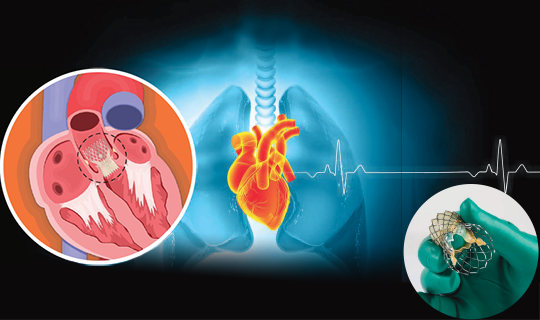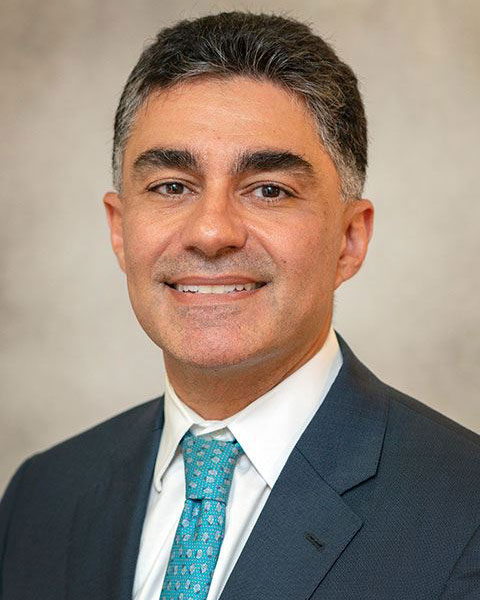
Minimally invasive therapies are easier on patients — and have lasting benefits.
The heart is a remarkable, durable organ, beating thousands of times a day for years on end. But eventually many people develop problems in the hardworking structures of the heart, especially its four valves — the aortic, mitral, tricuspid and pulmonic. For example, about one in 14 people over the age of 65 develops an especially common structural heart condition called aortic stenosis, in which the relatively large aortic valve thickens and stiffens, impairing the heart’s ability to pump enough blood to the body.

In the past, replacing — or in some cases, repairing — defective valves required open heart surgery, a well established, highly reliable procedure with low complication rates. In recent years, however, increasing numbers of heart patients have benefited from minimally invasive heart procedures that don’t require open heart surgery.
“These are truly ingenious technologies,” says Arash Salemi, MD, FACS, Clinical Chairman of Cardiothoracic Surgery, RWJBarnabas Health (RWJBH), Northern Region, and Professor of Surgery, Rutgers New Jersey Medical School. “They represent a paradigm shift in the treatment of structural heart conditions.”
A Cardiology Revolution
While open heart surgery often remains the best option for some people with valve disorders, minimally invasive valve procedures offer a number of advantages for patients who are good candidates for the treatments. Among the benefits are:
- Smaller incisions. Therapies such as transcatheter aortic valve replacement (TAVR) — one of the most common and well-established minimally invasive heart valve procedures — entail inserting a catheter (a thin, flexible tube) into a blood vessel, usually in the groin. After threading it to the heart, surgeons use the catheter to install a replacement valve inside the patient’s original valve. This approach eliminates the need to open the chest and access the heart through a large incision.
- No heart-lung machine. Avoiding open heart surgery means the minimally invasive surgical team doesn’t need to stop a patient’s heart during the procedure, and the patient doesn’t need to go on a heart-lung machine to keep blood and oxygen flowing to the body.
- Shorter hospital stays. An open heart surgery typically takes about 2½ hours, while a TAVR procedure takes about 30 minutes to an hour. After surgery, open-heart patients generally spend three to seven days in the hospital, including time in the intensive care unit, while most TAVR patients go home the day after surgery.
- No general anesthesia. While the complexities of open heart surgery require general anesthesia, most TAVR patients only need to be sedated.
- Faster recovery. “Where TAVR clearly wins from the patient perspective is in postoperative recovery, which is significantly shorter than with traditional open heart surgery,” Dr. Salemi says.
RWJBH researchers contributed to a recent study published in The New England Journal of Medicine that shows no difference in outcomes between TAVR and traditional open heart surgery after five years. Such research is important because it demonstrates that results of minimally invasive surgeries like TAVR stand up over time just as well as goldstandard traditional surgery.
“It’s becoming clearer that in terms of outcomes, durability and safety, patients undergoing open and transcatheter procedures end up in the same place,” Dr. Salemi says. “Minimally invasive heart procedures are a growing field, and we now have transcatheter treatments for all four valves, with aortic therapies being the most common.”
Are You a Candidate?
The first signs of structural heart problems like aortic stenosis are often subtle. “Typically, people just start slowing down without being aware,” Dr. Salemi says. “In many cases, a spouse notices that when they go on walks, the partner who used to be a step ahead is now a step behind.”
But fatigue becomes progressively worse, and other symptoms also often occur, including shortness of breath, chest tightness and lightheadedness. Valve disorders can quickly turn severe, increasing the risk of heart failure. Diagnosis often happens when a doctor detects a heart murmur during a routine checkup and advises follow-up testing such as a telltale echocardiogram.
When stenosis or other valve problems are found, a multidisciplinary team evaluates each patient’s options.
“A multidisciplinary team includes specialists from different medical backgrounds. These include surgical, interventional, imaging and anesthesia physicians. Each person brings a perspective that allows for a consensus to be achieved about the best pathway for treatment and individualized care,” says Dr. Salemi.
As research continues to confirm the quality and durability of outcomes from minimally invasive heart procedures, most patients are now considered at least potential candidates for these innovative treatments. TAVR and other minimally invasive heart valve procedures are especially common in patients over 65.
“We have a team of dedicated and committed professionals who provide world-class care to communities we serve throughout the RWJBarnabas Health system,” Dr. Salemi says. “Patients don’t need to travel to receive advanced cardiac care when we have state-of-the-art facilities, imaging technologies and highly trained providers and resources to deliver the highest-level services right in their own backyards. There’s really no reason to go anywhere else.”
To learn more about surgical and transcatheter aortic valve replacement, visit our TAVR page.
Whoever your heart beats for, our hearts beat for you. To connect with a top cardiovascular specialist at RWJBarnabas Health, call 888-724-7123 or request an appointment.
 View full issues of Healthy Together magazine by New Jersey region:
View full issues of Healthy Together magazine by New Jersey region: